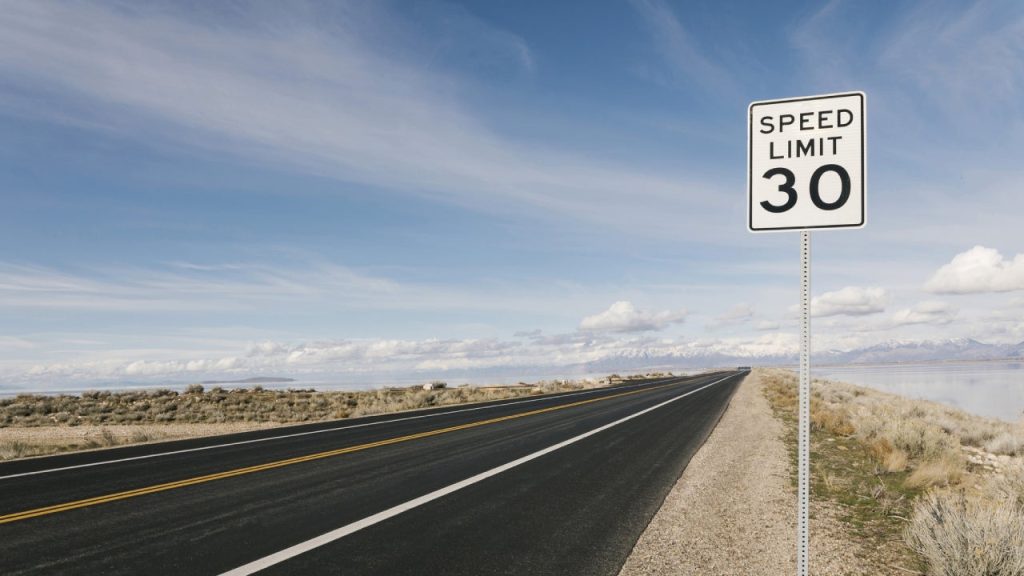Jessica Peterson/Getty Images
Speeding tickets can be pricey, but the real budget buster may be the increase in insurance costs associated with this infraction. The average full coverage rate increase following a speeding ticket in Utah is 21 percent. Fortunately, strategies like shopping around, avoiding future tickets and enrolling in a safe driving course may help you save, even with a less-than-perfect driving record.
How much is a speeding ticket in Utah?
The cost of a speeding ticket in Utah may vary widely based on factors such as how much over the speed limit you are driving and where the offense occurs. For example, the bail/fine amount varies based on how much you drive over the speed limit:
- 1 to 10 MPH over: $130
- 11 to 15 MPH over: $160
- 16 to 20 MPH over: $210
- 21 to 25 MPH over: $280
- 26 to 30 MPH over: $380
If you are found driving more than 31 MPH over the speed limit, it is classified as a class C misdemeanor, which requires a court appearance. You can also be fined as much as $680 for an offense in a construction zone and up to $790 for your second offense of speeding in a school zone. Utah drivers who receive a speeding ticket will also incur points on their license, typically between 35 and 75 points. If a driver over 21 collects 200 points or more within three years, their license can be suspended for three months to one year. Drivers under 21 can lose their license due to just one speeding violation.
When it comes time to renew your insurance in Utah, you may also be in for an increased premium, since it is likely that your insurer will review your driving record before renewing your policy. While the average rate for a Utah driver with a clean record is $2,118 for full coverage and $818 for state-mandated minimum insurance, a driver with a single speeding ticket on their record pays an average of $2,570 for full and $989 for minimum coverage insurance.
The cheapest car insurance for Utah drivers with a speeding ticket
Although your rate may increase following a speeding ticket or other infraction, there are still strategies you can use to find the most affordable coverage possible. To begin with, many insurance experts recommend that you ask for quotes from a range of carriers to find the company that offers the lowest rate for your circumstances. You may want to consider companies that have a reputation for writing cheap insurance in Utah.
Based on Bankrate’s research, these five companies may offer the lowest average full coverage rates to Utah drivers with a speeding ticket:
| Company | Avg. full coverage rate before speeding ticket | Avg. full coverage rate after speeding ticket | % difference after speeding ticket |
|---|---|---|---|
| Nationwide | $1,148 | $1,331 | 16% |
| Geico | $1,335 | $1,564 | 17% |
| USAA | $1,306 | $1,654 | 27% |
| Progressive | $1,513 | $1,971 | 10% |
| Auto-Owners | $1,684 | $2,156 | 28% |
What to do after a speeding ticket in Utah
Unfortunately, there is not much you can do to avoid a car insurance rate hike after getting a speeding ticket in Utah. But there are a few ways you can potentially lower your premium and get cheaper car insurance. For instance, getting multiple car insurance quotes, looking for discounts and raising your deductible might help you keep your car insurance costs lower.
Avoid future tickets
A speeding ticket typically only affects your insurance rates for three to five years, so avoiding future tickets and accidents is key to bringing your rates back down over time. You may be able to demonstrate to your insurer that you’re cleaning up your driving by enrolling in telematics or taking a safe driver course.
Look for discounts
You can find potential car insurance discounts from most car insurance companies in Utah. However, the exact savings available are unique to each provider. Most car insurance companies offer several discount opportunities, though, and you might qualify for several of them. Some of the most common car insurance discounts include bundling, good student and paperless billing.
Raise your deductible
A deductible is an out-of-pocket expense you must pay after a comprehensive or collision claim is approved; the claims check your insurer sends will have this amount deducted. The higher your deductible, the lower your premium will be. Make sure, however, that the deductible amount you select is an amount that you feel comfortable paying on short notice.
Frequently asked questions
Methodology
Bankrate utilizes Quadrant Information Services to analyze October 2024 rates for all ZIP codes and carriers in all 50 states and Washington, D.C. Rates are weighted based on the population density in each geographic region. Quoted rates are based on a single, 40-year-old male and female driver with a clean driving record, good credit and the following full coverage limits:
- $100,000 bodily injury liability per person
- $300,000 bodily injury liability per accident
- $50,000 property damage liability per accident
- $100,000 uninsured motorist bodily injury per person
- $300,000 uninsured motorist bodily injury per accident
- $500 collision deductible
- $500 comprehensive deductible
To determine minimum coverage limits, Bankrate used minimum coverage that meets each state’s requirements. Our base profile drivers own a 2022 Toyota Camry, commute five days a week and drive 12,000 miles annually.
These are sample rates and should only be used for comparative purposes.
Incidents: Rates were calculated by evaluating our base profile with the following incidents applied: clean record (base) and single speeding ticket.
Read the full article here










